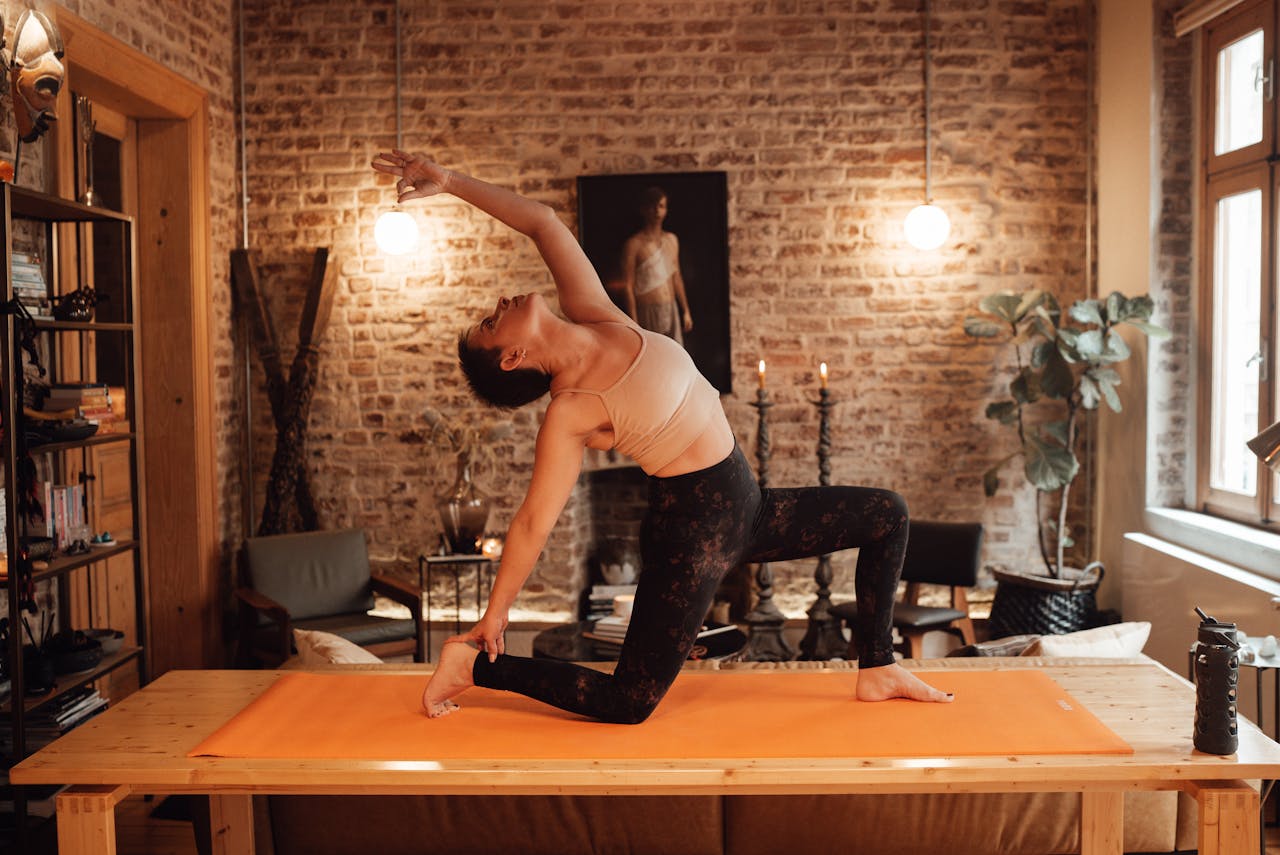
Table of Contents
Yoga means something a little different to everyone. This comprehensive guide will cover everything and guide you to more detailed resources that fit your particular interests.
Feel free to navigate each section individually within the table of contents and skip ahead to what you’d like to read!
Yoga Definition
The word yoga is Sanskrit in origin and means “union.” In an ancient context, yoga may have begun over 5000 years ago, as a form of self-shamanism, in the Indus Valley region, around 3000 BC. It then grew in India as one of six philosophical systems within Hinduism. The discipline originally encompassed mental, physical, and spiritual practices. However, yoga was primarily a spiritual practice that aimed to bring the mind and body in universal harmony.
In the modern sense, yoga retains many of its ancient traits, including harmonizing the mind and body and focusing on spirituality. But today, more emphasis is placed on asana (bodily poses) and the physical aspects of yoga in general. In essence, the promotion of relaxation and fitness has come to the fore for modern yoga, and the practice is primarily categorized by either “style” or difficulty level.
History of Yoga
Although origin dates vary, the practice of yoga goes back approximately 5000 years — to 3000 BCE. Traditional Yoga began in ancient India as one of six orthodox schools of Hindu philosophy, as per references in ancient Sanskrit texts — namely, the Vedic Sanskrit texts, the Rigveda, and the Upanishads.
Seeking Liberation
The original goals of yoga focused on spiritual development and self-realization. Many sources cite Moksha (liberation) as the ultimate goal. In this state, the practitioner would be free of suffering and fully aware of their higher consciousness.
Transformation of Yoga
One of the critical texts that spurred the popularity of yoga in the West was the Yoga Sutras, by a sage named Patanjali between 500 BCE and 400 CE. The Yoga Sutras text includes 195 philosophical aphorisms about yoga, including an explanation of ashtanga (the eight limbs of yoga), the basis for modern-day yoga practice.
Yoga reached the West slowly, beginning in the 1890s and increasing in popularity until the mid-20th century when it truly began to flourish. Swami Vivekananda is often credited with bringing yoga to the West around 1893 when he emigrated to the United States from India.
Hatha yoga became a practiced exercise in the United States in the 1930s and 40s, after Sri Krishnamacharya had taught it to a number of the significant Indian teachers of the West. Hatha Yoga gained momentum in the 1960s and reached its peak in the 70s when New Age idealism emerged in the post-60s era, and interest in Eastern spirituality was high among young Americans. In the 1980s, when several studies reported the health benefits of yoga, yoga was promoted as an exercise with its physical benefits taking precedence over its spiritual and mental ones.
Eight Limbs of Yoga
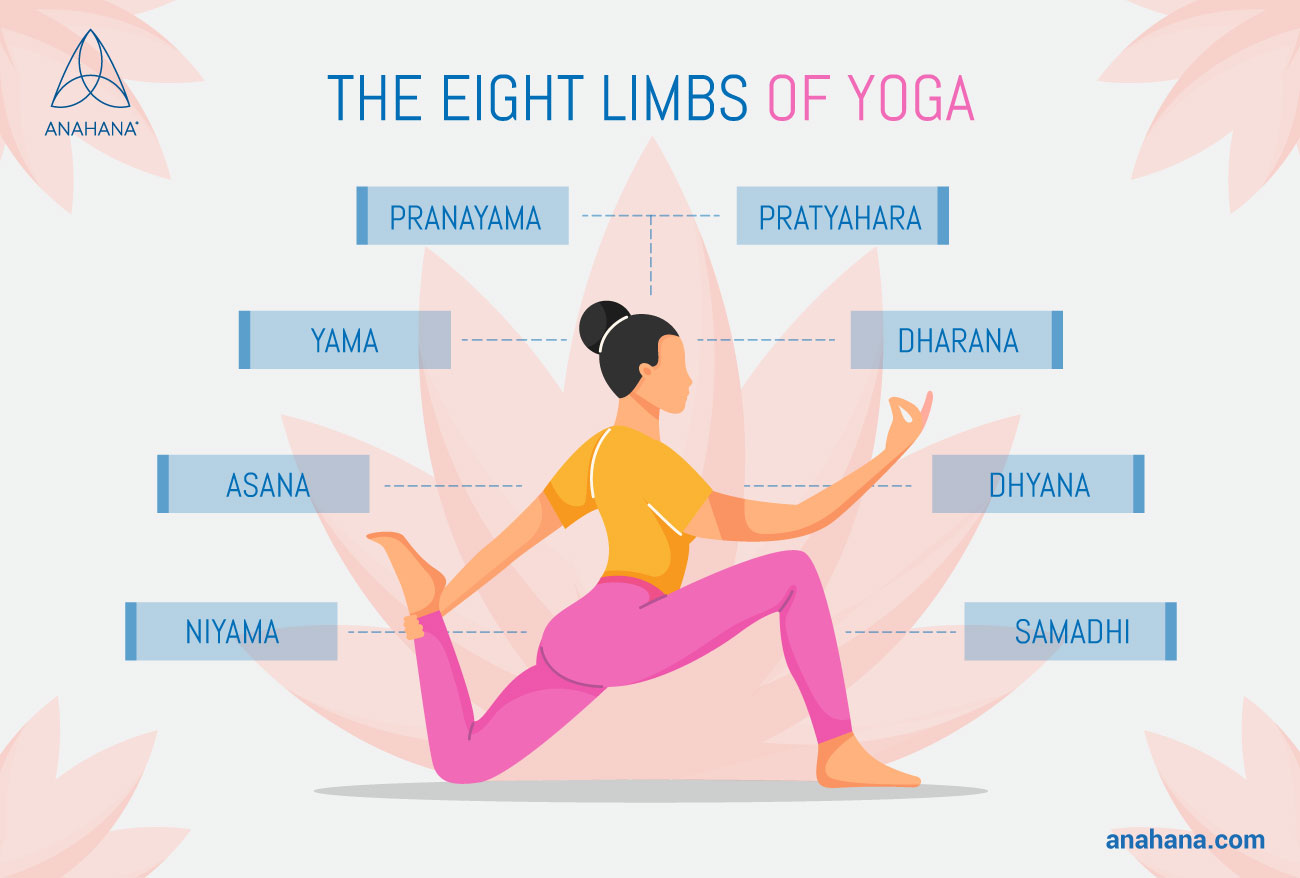 Based on a classical ashtanga (eight-limbed) yoga model, which Hatha yoga stems from, the systemic eight-branched discipline encompasses a non-linear process aiming to attain universal unity and samadhi bliss.
Based on a classical ashtanga (eight-limbed) yoga model, which Hatha yoga stems from, the systemic eight-branched discipline encompasses a non-linear process aiming to attain universal unity and samadhi bliss.
These are the eight limbs of yoga:
Yama (interpersonal study): Living harmoniously with the surrounding world and handling your conduct correctly
Niyama (intrapersonal study): Practicing key personal observances aimed at improving the yoga practice itself
Asana (postures): Refining the bodily positions of yoga, including a focus on feeling tensionless and steady in each posture
Pranayama (refinement of breath): Controlling and regulating the breath — in particular, deep diaphragmatic breathing
Pratyahara (refinement of the senses): Improving one’s attitude toward the senses — notably, how the senses should serve the mind instead of the other way around
Dharana (concentration): Honing focus and concentration by withdrawing the senses, visualizing, and centralizing the breath.
Dhyana (meditation): Being absorbed by meditation — not “doing” anything to meditate, but instead allowing oneself to be taken in and enveloped by the practice.
Samadhi (the settled mind): Achieving enlightenment or bliss through bettered relationships with the inner self and the outer world.
7 Chakras
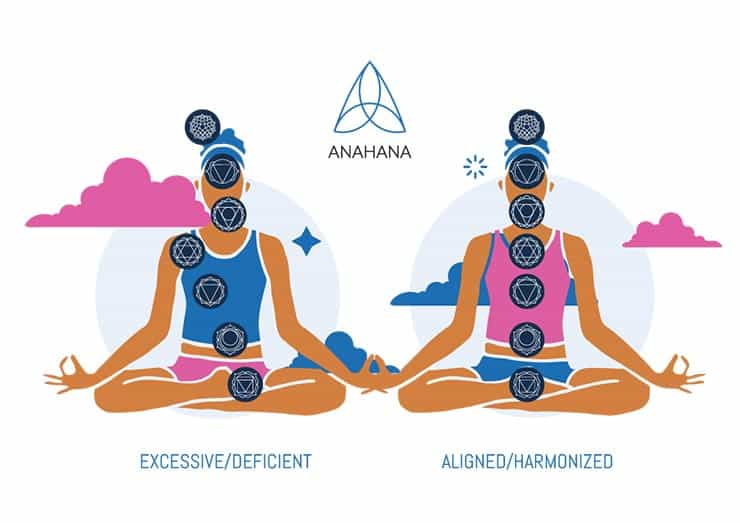 Chakras are energy centers, like mini-brains, that organize and transmit power throughout the body like “software” programs in the subtle body that run the “hardware” of the physical body. Seven main chakras run along the spine, creating an energy system that permeates the whole body. Each chakra relates to the physical body through a nerve center (the nervous system) and a hormonal gland (the endocrine system). There are also chakras in the hands and feet and other minor chakras throughout the body. Each chakra has its own Sanskrit name, mantra, and associated color frequency:
Chakras are energy centers, like mini-brains, that organize and transmit power throughout the body like “software” programs in the subtle body that run the “hardware” of the physical body. Seven main chakras run along the spine, creating an energy system that permeates the whole body. Each chakra relates to the physical body through a nerve center (the nervous system) and a hormonal gland (the endocrine system). There are also chakras in the hands and feet and other minor chakras throughout the body. Each chakra has its own Sanskrit name, mantra, and associated color frequency:
-
Crown chakra (violet): Sahasrara in Sanskrit, this chakra attaches us as close as possible to the spiritual world, including the dynamic energy that brings us nearer to enlightenment.
-
Third eye chakra (indigo): Ajna in Sanskrit, this chakra represents a higherintuition (the third eye) and our potential for focus and improved concentration. The mantra is Om.
-
Throat chakra (blue): Vishuddha in Sanskrit, the chakra encompasses speech and writing. It focuses on recovery and transformation, primarily through channels of communication. The mantra is Ham.
-
Heart chakra (green): Anahata in Sanskrit, this chakra holds our potential for compassion, adoration, and love. This love applies to love for others and ourselves. The mantra is Yam.
-
Solar plexus chakra (yellow): Manipura in Sanskrit, this chakra represents the ego, including our power and other potentially more threatening impulses such as anger and wrath. The mantra is Ram.
-
Sacral chakra (orange): Svadhisthana in Sanskrit, this chakra is the center of intuition, creativity, and self-confidence. The mantra is Vam.
-
Root chakra (red): Muladhara in Sanskrit, this chakra represents centeredness, the feeling of being grounded, and our relationship with the earth. The mantra is Lam.
Yoga Mantras and Yoga Chants
Mantras and chants are often used in yoga to help practitioners achieve a higher state of consciousness. This practice of using either fierce or silent internal sounds to tap into the transcendental “supreme sound” (also known as shabda brahman) or “supreme voice” (para-vac) is thousands of years old.
Numerous mantras and chants can be used in yoga, but these are four of the most popular:
Om: Pronounced “aum,” this mantra is central to all yoga chanting. Om is the all-encompassing vibration that permeates the cosmic universe.
Om Mani Padme Hum: Mani means “jewel,” Padme means “lotus” (“wisdom”), and hum means “indivisibility.” Thus, the goal of this mantra lies in transforming the body, mind, and speech into pure enlightenment through unity of wisdom and method.
Om Shanti Om: Shanti means “peace” in Sanskrit. Chanting Shanti multiple times, along with om, strengthens the peace of various parts of the practitioner — namely, the mind, body, and voice.
Om Namah Shivaya: The five-syllable om namah shivaya mantra refers to the act of bowing or adoring Shiva, who is a principal deity of Hinduism. The mantra is meant to calm the spirit and bring the practitioner closer to themselves and a connection to joy and strength.
History of “Om”
The first primordial sound of the universe’s creation was om. The mantra originates within the Hindu tradition as the most powerful and vital mantra used in the practice of yoga.
Science of Yoga
Yoga has become a well-known practice for multiple spiritual reasons, but its success also stems from its wide array of physical and mental implications and benefits. These cannot be understated.
A wide range of scientific research studies has confirmed that yoga can be a life-changing practice, leading to:
-
Better cardiovascular health
-
Decreased heart rate and lower blood pressure
-
Reduced joint and muscle pain
-
Lower rates of cortisol (stress hormone)
-
Enhanced vagal activity (related to digestion, blood pressure, heart rate, communication, sweating, and more)
-
Better regulated blood sugar levels
-
Easier weight management
-
Improved breathing
-
Better sleep
-
Less muscle tension and headaches
-
And other benefits.
Where mental and emotional health is concerned, yoga has also been shown in scientific studies to reduce stress and anxiety across the board. Positively impacting many of the above-listed physical health risks, the practice of yoga can also lead to overall happier, healthier mental states. Those who regularly practice yoga report less daily anxiety and lower rates of depression and other mental health disorders.
Types of Yoga
There are numerous types of yoga, all of which have specific goals and benefits.
-
Hatha Yoga is likely the most traditional approach to the practice of yoga. The focus is generally on the physical postures (asanas), and there are accompanying behavioral elements to the practice. Hatha yoga is usually a slower, more mindful approach to yoga than some other modern styles. It is an excellent yoga for beginners and their transition into yoga.
-
Vinyasa Yoga focuses on the breath and stringing together various asanas (postures) to perform seamless sequences, which create a unified “flow.”
-
Ashtanga Yoga follows traditional yoga sequences, starting with the Primary Series Pattabhi Jois developed in Mysore, India. It is a challenging, dynamic vinyasa style. Ashtanga also refers to the eight limbs of yoga as identified in the Yoga Sutras.
-
Kundalini Yoga uses specific postures, mantras and chants, meditations, and unique kriyas (practices) to connect more closely with yourself and enlighten your consciousness. By practicing Kundalini yoga with a certified yoga instructor, you may experience the Kundalini awakening and the spiritual bliss.
-
Gentle Yoga focuses on therapeutic positions and few movements. The main benefits of this practice are improved breathing, gentle stretching, and reduced stress and anxiety. And it is all achieved through gentle yoga sequences and a process called Nerve Flossing or Nerve Glide.
-
Restorative Yoga helps those struggling with mobility issues. It can help individuals recovering from an injury or those with physical disabilities as movements are rare, and only a few slow stretches encompass the bulk of each sequence.
-
Yoga Nidra is a relaxation-based and meditative form of yoga that brings the practitioner to a semi-conscious, near-sleep state. Research has shown some forms of Yoga Nidra (such as iRest) can be an effective treatment for anxiety, insomnia, and symptoms of PTSD.
-
Kriya Yoga focuses on carrying the practitioner to an advanced state of spiritual development and awakening by taking specific yogic actions, “kriyas” to better oneself to live a more fulfilled life.
-
Tantric Yoga / Tantra aims to help practitioners get more in touch with their physical selves — through personal exploration and energy connections, enhancing their physical well-being and spiritual growth.
-
Yin Yoga or Taoist yoga encompasses comfortable passive poses that don’t require much effort and often involve the use of props. This type of yoga helps with flexibility by stimulating the connective tissue or the fascia, in the joints, and along meridian lines.
-
Chair Yoga is most helpful for the elderly and those with limited mobility. Practitioners sit in a chair (or stand beside one) while performing poses and movements.
-
Power Yoga encompasses a full-body workout. Classes are more active, strength-oriented, and movement-based than other more traditional styles of yoga.
-
Bikram Yoga comes from the Indian yogi Bikram Choudhury. Two breathing exercises and 26 postures make up Bikram yoga, performed in a hot, humid room with bright lighting.
-
Hot Yoga is performed in a studio at around 80 to 100 degrees Fahrenheit. Unlike Bikram Yoga, postures and breathing exercises may vary.
-
Iyengar Yoga foundations originate from Ashtanga yoga (the eight limbs of yoga). Iyengar yoga became popular with the help of a famed Indian yogi named B.K.S Iyengar. Props and a focus on breath control are central to this practice.
-
Self Awakening Yoga originated with Dr. Brahmanand Don Stapleton, Ph.D. It involves unique movements, such as tapping, unwinding, thumping, rolling, etc.
-
Kripalu Yoga is perfect for all levels, including beginners. The goal is to perform a gentle (Hatha) yoga practice that focuses on spiritual transformation, compassion, and physical healing.
-
Sivananda Yoga originated with Swami Vishnudevananda in the 1950s. It encompasses five core principles: breathing, relaxation, diet, physical activity, and positive thoughts.
-
Yoga Therapy is the practice of using yoga as a clinical therapy for emotional challenges, mental health disorders, and physical ailments. It aims to push practitioners to higher health and wellbeing overall.
-
Prenatal Yoga is for women who are pregnant or expecting to become pregnant. The safety and health of the baby and mother are at the center of this calming, usually gentle practice.
-
Goat Yoga is a novel yoga class that involves practicing alongside happy baby goats that’ll likely have fun climbing on top of you.
-
Integral Yoga is a type of gentle hatha yoga. It originated with the Indian yogi Sri Swami Satchidananda in the 1960s. The goal is to integrate or harmonize the mind, body, and spirit.
-
Acro Yoga combines yoga with traditional acrobatics. This recreational version of yoga is often associated with dance, circus performance, and physical prowess in general.
-
Aerial Yoga is performed in a suspended attitude, using a silk hammock hung securely from the ceiling as a prop.
-
Raja Yoga is like ashtanga yoga. It is the yoga of peace, calm, and serenity and involves eight critical stages (limbs) of self-realization.
-
Karma Yoga is also called karma marga. The goal is to help practitioners act based on Hindu dharma, regardless of the personal benefits. It is said to be the yoga of action and
-
Baby Yoga is for infants and toddlers. In some cases, parents perform alongside their children; in others, the class may involve only babies and toddlers. The aim is to improve their flexibility, strength, and coordination.
-
Couples Yoga is for couples to perform alongside each other. Physically moving together can improve any relationship's physical and emotional aspects.
Benefits of Yoga
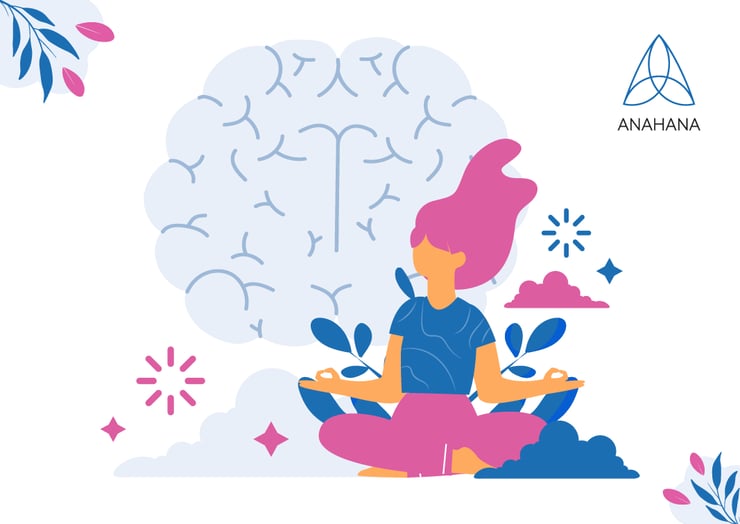 The benefits of yoga range from reduced muscle tension and lower blood pressure to fewer headaches and better sleep.
The benefits of yoga range from reduced muscle tension and lower blood pressure to fewer headaches and better sleep.
-
Increased Flexibility: Yoga teaches gentle poses and movements while also challenging the practitioner to push their flexibility further than they would with other exercises or in non-active daily life. Flexibility develops by engaging in repetitive poses and holding them for a substantial time.
-
Better Sleep: With regular yoga practice comes reduced bodily tension and lower rates of stress, both of which aid sleep. Yoga Nidra for sleep, in particular, can also help yogis sleep better and for longer.
-
Reduced Stress and Anxiety: Deep breathing exercises, practiced focus, and an emphasis on the mind-body connection help yoga practitioners shed away stress and anxiety — both in the short- and long-term, helping with your stress management.
-
Improved Mental Focus: Yoga teaches the importance of honing one’s mental clarity, pushing the practitioner to let extraneous thoughts and feelings float away. With consistency, this practice can significantly improve concentration and mental agility.
-
Better Resilience: The discipline of regular practice combined with the regular shedding away of oft-scattered thoughts, feelings, and emotions teaches yogis how to stay strong and resilient even when they’re not actively practicing.
-
Reduced Inflammation: Certain illnesses and poor lifestyle choices (bad diet, low levels of physical activity, and high levels of stress, for example) can lead to bodily inflammation. Yoga can reverse these indicators, leading to lower inflammation and lower incidents of inflammation-related illnesses and medical conditions.
-
Improved Breathing: Besides focusing on physical movements and improved mental energy, yoga is an exercise in breathing. The practice teaches people how to breathe correctly and breathing techniques to breathe deeply and fully — something critical to cardiovascular health and stress reduction.
-
Better Heart Health: Reduced inflammation and stress combined with improved deep breathing and mental focus contribute to better heart health. Those who practice yoga are far less likely to struggle with high blood pressure and heart-related illnesses.
-
Better Overall Health: Compared to those who don’t practice yoga, yoga practitioners are less likely to be overweight or obese. They also take fewer medications and tend to live longer.
Risks of Yoga
It is essential to take responsibility for their choices and actions on the path. An experienced yoga instructor will help educate students about tools and techniques. More importantly, it will empower students to listen to their bodies and develop their inner teacher and internal practice.
Students should beware that some instructors may either not be trained well or may not be experienced in teaching, and can even potentially be abusive by not respecting the boundaries of the individual student. Respecting one’s boundaries is an integral part of yoga and the first principle of non-violence.
-
Possible Injuries: Challenging yoga postures and movements may result in excessive strain and subsequent injury, especially for those new to the practice.
-
Repetitive Stresses: Regular yogis may also encounter stress injuries caused by continuous strain on particular muscles and joints.
-
Ego-Driven Yoga: Pushing too far to impress, like in any physical practice or activity, yoga can become competitive. It’s important to remember that making yoga competitive threatens the practice’s ultimate benefits.
-
“Guru” Power Abuse: There have been many abusive teacher/student power dynamics incidences. It is essential for the student to maintain healthy boundaries, both personally and interpersonally, and report inappropriate behavior.
Yoga Poses / Asanas
Asana is Sanskrit for “pose” or “body posture,” described as: “to sit in the seat of the Self.” These positions are the foundation of any yoga practice.
There are many yoga asanas, and they can be used interchangeably to make up sequences and flows. Here are the most essential asanas.
Neutral Poses
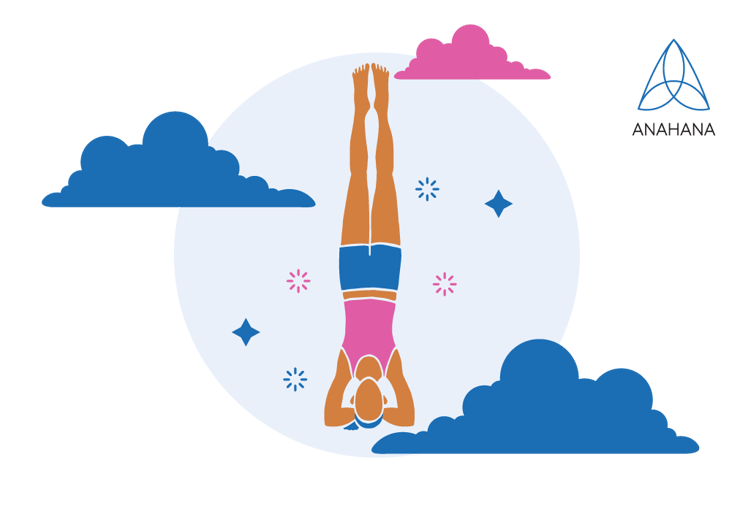
-
Adho Mukha Vrksasana / Handstand is essentially Mountain Pose flipped upside down. This advanced pose should only be attempted with a spotter at first, but once mastered, it provides strength to the arms and shoulders, improves balance, and relieves stress.
-
Sirsasana / Headstand is similar to the Handstand Pose, but the top of the head creates a tripod of support and bent arms. It is excellent at strengthening the back, shoulders, and arms.
-
Tadasana / Mountain Pose is the basis for most standing asanas. While it may appear that it is “just standing,” it involves attention to many postural and alignment-related details.
-
Urdhva Hastasana / Upward Hand Stretch is an energetic pose performed by standing and raising hands above the head. This pose can improve digestion and stretch out the shoulders and belly.
-
Chaturanga Dandasana / Four-Limbed Staff Pose is a rather challenging but common, plank pose in the Sun Salutation sequence. It helps to tone the abs and strengthen the arms.
-
Vasisthasana I / Side Plank is another rather challenging pose, which involves balancing in a side plank with legs stacked and one arm supporting your upper body weight. Benefits include strengthened arms, legs, wrists, abs, and improved balance.
-
Savasana / Corpse Pose is the final supine pose (lying on the back, face up) for resting after yoga practice. It is also the core position for Yoga Nidra.
Flexion Poses (Hips)
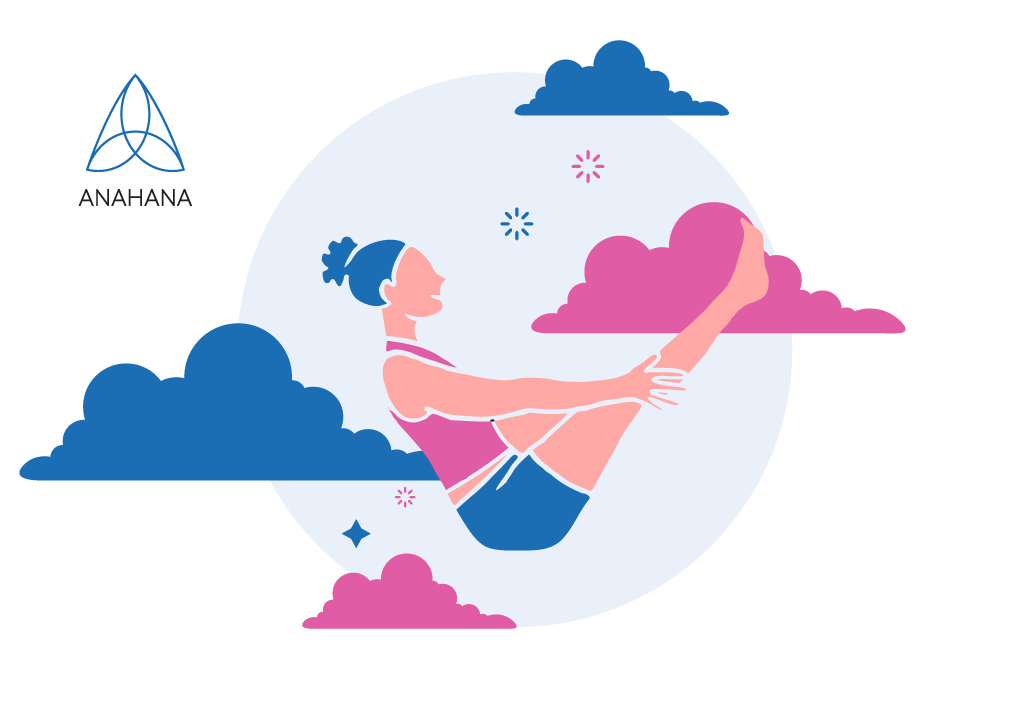
-
Navasana / Boat Pose can be a challenging pose that strengthens the deep hip flexors and abs. It requires balancing your tailbone and sitting bones while extending your legs and arms straight out.
-
Adho Mukha Svanasana / Downward Dog is a famous stretching pose that is wonderful for rejuvenating and energizing the entire body and mind while strengthening the legs and arms. It mainly involves a deep stretch of the hamstrings, calves, and shoulders
-
Ardha Attanasana / Half Forward Fold is an intense half-stretch standing pose that is beneficial for stretching the front of the torso and strengthening the back.
-
Virabhadrasana III / Warrior 3 Pose is a pose that focuses heavily on honing your balance and maintaining stillness while steadying yourself on just one leg. It helps strengthen the legs and ankles, tone the abdomen, and improve overall balance and posture.
-
Dandasana / Staff Pose is simple in appearance but involves several vital details. Practitioners sit on the floor with legs outstretched and together while extending the torso slightly forward and sitting straight.
Flexion Poses (Hips and Spine)
-
Uttanasana / Standing Forward Fold is particularly helpful at relieving stress and calming the nervous system. The deep bend at the waist provides an excellent stretch for the hamstrings and calves and clears the mind.
-
Parsvottanasana / Pyramid Pose is an intense side stretch that is wonderful for improving balance and alleviating pain and discomfort in the lower back.
-
Balasana / Child's Pose is a resting pose performed in a kneeling position with forehead on the floor. It is calming and provides an excellent stretch for the entire back.
-
Bakasana / Crow Pose is a challenging pose that involves balancing on the hands in a squat-like position. The pose strengthens the forearms and wrists while excellently stretching your upper back.
-
Malasana / Garland Pose (Yogi Squat) is perfect for stretching the groin, back, and ankles. This squatting pose also opens the hips while even toning the abs.
-
Upavistha Konasana / Seated Angle Forward Fold is ideal for opening the back and providing a stimulating effect to the nervous system. It is also helpful in relieving pain from sciatica and lengthening the hamstrings.
Flexion Poses (Spine)
-
Sarvangasana / Shoulder Stand is an inverted pose used at the end of a yoga session to encourage circulation and strengthen the spine and core.
Extension Poses
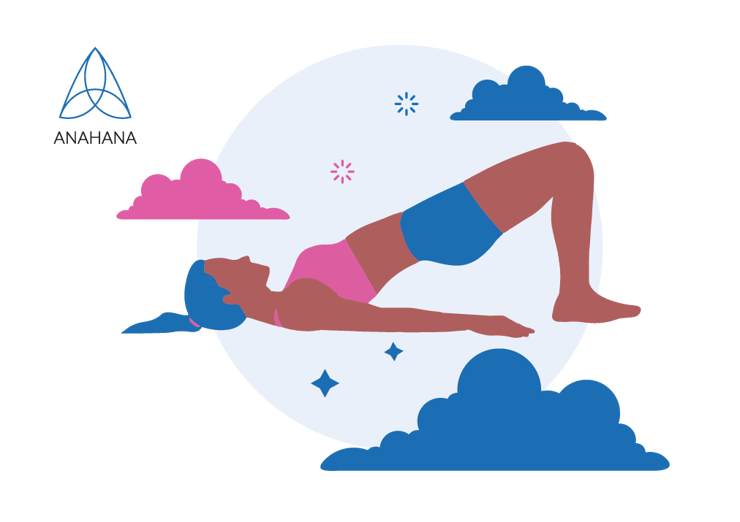
-
Setu Bandha Sarvangasana / Bridge Pose is performed by pushing up from a supine position with knees bent and feet flat on the floor. The pose gives a great stretch to the abdominal muscles and thighs while helping to reduce anxiety and relax the mind.
-
Pincha Mayurasana / Peacock (Feather) Pose is similar to the Headstand Pose; however, the difference is that only the elbows and forearms are planted, and the head does not touch the ground. This pose improves balance and strengthens the shoulders, arms, and abs.
-
Salabhasana / Locust Pose is a magnificent pose to prepare the body for deeper stretches involving backbends. It can also improve posture, strengthen the spine, and help relieve pent-up anxiety.
-
Bhujangasana / Serpent (Snake) Pose is perfect for opening the chest and heart. It also increases flexibility in the spine, tones the buttocks, and helps reduce pain from sciatica.
-
Urdhva Mukha Svanasana / Upward Dog Pose is performed after pushing up from a prone position. It gives a deep stretch to the chest and abs while strengthening the upper arms and forearms and stimulating the abdominal organs.
- Urdhva Danurasana / Wheel (Bow) Pose is an advanced backbend pose that can provide a jolt of energy and improve flexibility in the spine and thighs.
Rotation Poses (Hips)
-
Virabhadrasana II / Warrior 2 is a standing position, which provides a good stretch for the ankles and legs. It emphasizes concentration, strength, and stability.
-
Utthita Parsvakonasana / Extended Side Angle is a side-lengthening standing pose that gives the hamstrings and groin area a deep stretch. Continual practice increases stamina and improves focus.
-
Utthita Trikonasana / Extended Triangle is a common standing pose that strengthens the inner thighs, calves, and hamstrings while lengthening the back and boosting energy to the entire body.
-
Ardha Chandrasana / Half Moon is a pose that involves half your limbs having contact with the ground. One hand and one foot provide support while the other limbs are extended, giving an excellent stretch to the shoulders, chest, groin, and hamstrings.
-
Garudasana / Goddess Pose is a pose that requires focused concentration and a reserve of endurance. You must balance just one slightly bent leg while carefully wrapping the arms and holding a balanced position.
-
Baddha Konasana / Cobbler's Pose helps open the hips and give them a much-needed expansion. The seated position also provides a lengthening stretch for the back and shoulders while delivering soothing stress relief.
-
Janu Sirsasana / Knee-to-Head Forward Fold is a seated pose involving a slight spinal twist and an excellent stretch for the back, shoulders, hamstrings, calves, and ankles.
-
Gomukhasana / Cow (Face) Pose is a challenging position that requires the legs to be crossed while seated, with the arms bent at the elbow — one up near the ear and the other down and around the back. This pose offers a good stretch for the shoulders, thighs, and triceps.
-
Virasana / Hero Pose is a seated pose that requires the knees to be bent beneath your seat, with feet splayed to either side. The position offers a deep stretch to the thighs and is an excellent alternative to Lotus Pose for meditation.
Rotation Poses (Spine)
-
Parivrtta Trikonasana / Rotated Triangle is a deep twisting position that stretches the hamstrings, opens the heart, and improves balance. While it can be a challenging pose, it’s important not to force the rotation, leading to injury.
-
Ardha Matsyendrasana / Half King Turn is a seated pose that involves shifting one leg over the other and twisting the upper body in the opposite direction. This pose strengthens the lower back and promotes flexibility in the spine.
Yoga Stretches
Various yoga poses and stretches can be used to increase flexibility and strength in specific areas of the body:
-
Hip Stretches: To stretch and strengthen the hips, it’s important to stretch and strengthen the entire region of the pelvis. Some of the best stretches for this area include Warrior II, Child’s Pose, Pigeon Pose, and Cobbler’s Pose.
-
Neck Stretches: Instead of using at-home massage tools or digital pressure to combat neck and shoulder pain, try yoga stretches such as Standing Forward Pose and Cow (Face) Pose. Also, try using a yoga strap (yoga belt) with positions such as Locust Pose, which is excellent for stretching the upper back and chest.
-
Back Stretches: The best stretches for the back include bridge pose, upward-facing dog, and locust pose. These will improve spinal mobility and strengthen the core, which in turn will strengthen the back muscles.
-
Leg Stretches
-
Quads: To increase flexibility and reduce tension in the quads, try Child’s Pose and the Crescent Lunge.
-
Calves: To increase flexibility and reduce tension in the calves, try Pyramid Pose and Thunderbolt Pose (with a rolled towel placed behind the knees).
-
Hamstrings: To increase flexibility and reduce tension in the hamstrings, try Downward Dog and Seated Angle Forward Fold.
-
Common Yoga Terms
Aside from the myriad of individual posture names, yoga comes with several common terms that can sometimes confuse people unfamiliar with the practice.
-
Asana means “posture” in Sanskrit, and it is one of the eight limbs of yoga. According to the Yoga Sutras, all the yoga asanas intend to be comfortable and steady.
-
Pranayama is Sanskrit for two words: “life force” (Prana) and “expansion” (Ayama). Breath control through pranayama is an integral part of the yoga practice.
-
Chakra means “circle” or “spinning wheel.” We each have seven chakras that run the length of our spine and make up our main energy channel.
-
Drishti means “focused gaze.” It is a means for developing your discipline and concentration during yoga. There are nine drishtis in Ashtanga yoga, each with its focus.
-
Namaste means “I bow to you.” It is a common greeting used at the beginning and end of yoga class.
Yoga Online
Technological advancements have made online yoga learning a fantastic option for many practitioners. Taking part in online yoga classes with an experienced and certified yoga instructor is convenient, affordable, and often more comfortable than heading to a physical brick-and-mortar studio. Likewise, private yoga lessons can help you hone your abilities and improve all aspects of your practice at a much faster rate.
Yoga at Home
Performing yoga at home can be a delightful way to learn and practice yoga at your own pace, surrounded by the comforts of home, using a quality yoga mat and other props (where necessary). Advanced yogis may choose to manage their practice or use online videos, while beginners can use virtual yoga courses or individual instruction from yoga experts.
Yoga For
Yoga is for everyone. No matter age, gender, background, or ability level, one can practice yoga and reap its benefits.
Here’s how all groups can benefit from yoga:
-
Kids: Yoga for kids help them deal with issues such as stress, anxiety, and physical inactivity is just as important to treat in kids as they are in adults. Yoga is the perfect physical activity for helping children improve their activity levels, awareness, focus, and inner strength.
-
Seniors: Yoga for seniors helps elderly adults stay physically active without risking injury. The soft movements of chair yoga, gentle yoga, and restorative yoga are especially beneficial for seniors.
-
Athletes
-
Skiers will do well to use yoga to maintain focus and quick decision-making skills while on the slopes. Improved agility and coordination are also vital benefits for skiers.
-
Golfers can improve their swing and range of motion overall by practicing yoga.
-
Surfers can benefit significantly from the improved balance, stability, and strength that a regular yoga practice can provide.
-
Hockey players can soothe sore muscles and prevent further injuries by practicing regular yoga.
-
Runners can use yoga to stretch, increase flexibility, and prevent injuries. Especially if the practitioner is suffering from runner's knee.
-
Baseball players may profit from yoga’s strength-training benefits and focus on deep breathing and oxygen distribution (particularly useful while running the bases).
-
Basketball players will specifically benefit from increased mobility and flexibility, improving alongside yoga practice.
-
Soccer players can use yoga to increase their concentration and focus while preventing injury and stretching sore muscles.
-
Football players rarely slow down for gentle moving and focused poses; therefore, yoga can be used as a successful cross-training tool for these athletes.
-
Tennis players can benefit from yoga’s focus on balance and coordination while improving their mental agility.
-
-
The Workplace: Modern workplaces are now implementing group yoga classes and insurance-covered yoga instruction. This practice serves both employees (their physical health and stress levels) and the company's overall goals.
-
Families: Doing any activity as a family can enhance the familial bond and create more harmony in your household. Essentially any type of yoga can be practiced as a family. It’s a beautiful way to calm stress, clear the mind, and get some exercise while spending time together.
Injuries / Chronic Pain
-
Sciatica: Yoga can do wonders to reduce sciatica's intense, burning pain. Try incorporating Locust Pose, Cobra Pose, and Child’s Pose.
- Pain Management
-
Back Pain: Yoga is excellent for improving back pain as a focus on core strength and stretching are central to the practice. Just be sure to perform gently, as yoga performed incorrectly can exacerbate pain.
-
Neck Pain: Pain and discomfort in the neck (and shoulders) are often caused by poor desk posture and our constant use of smartphones. Yoga stretches these areas of the body in critical ways that, in turn, curb discomfort and release tension.
-
Hip Pain: Be careful when doing yoga for hip pain that you do not make the pain worse by pushing yourself too hard. The best yoga poses for hip pain include Pigeon Pose and Bound Angle Pose.
-
Knee Pain: Consistent yoga practice can help align the patella and strengthen the interior thighs, which is beneficial for curbing knee pain.
-
-
Weight Loss: Though not all yoga targets weight loss, certain dynamic and active yoga types can undoubtedly help practitioners burn more calories and build muscle strength.
-
Stress Relief: Yoga’s focus on deep breathing and letting extraneous thoughts fade away can help immensely limit the harmful effects of stress and chronic anxiety.
-
Posture: Because of yoga’s emphasis on correct positioning and holding (sometimes challenging) poses, posture improves quickly.
-
Pregnancy: Prenatal and postnatal yoga can help mothers feel healthier and more comfortable with their changing bodies.
Yoga Breathing
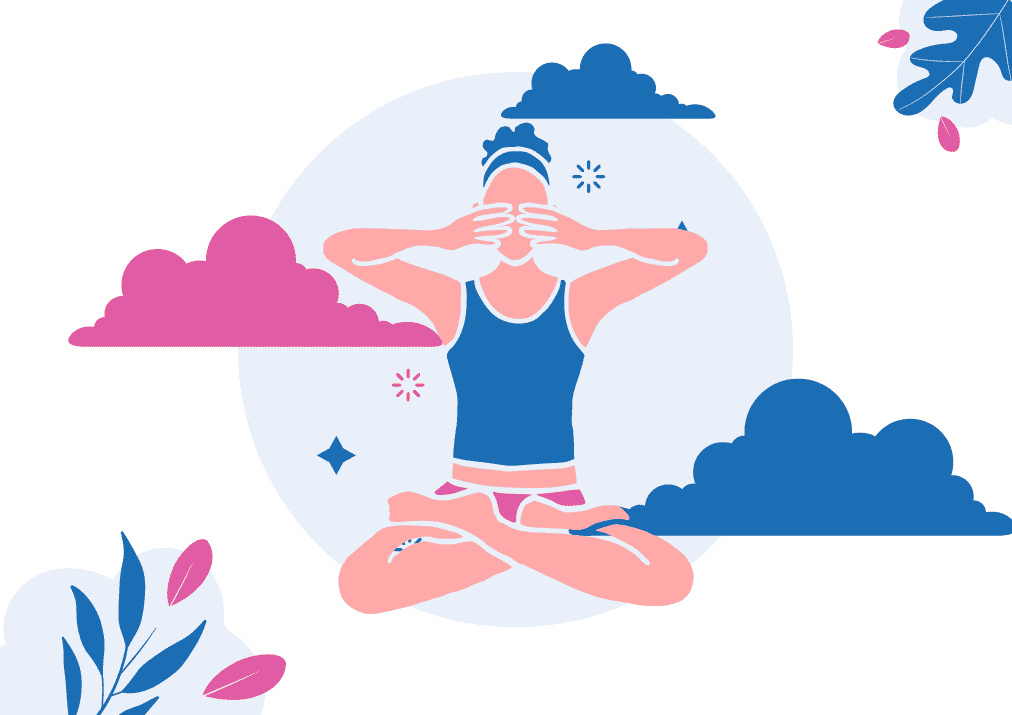 In Sanskrit, pranayama means “breath control.” Prana means “life force,” and Ayama means “expansion.” Breath control through pranayama is an integral part of any yoga practice, and there are numerous types of pranayama breathing.
In Sanskrit, pranayama means “breath control.” Prana means “life force,” and Ayama means “expansion.” Breath control through pranayama is an integral part of any yoga practice, and there are numerous types of pranayama breathing.
Here are eight to be aware of:
-
Dirga (three-part breath) calms and grounds you. It involves inhaling to fill the belly, rib cage area, and chest with air before reversing the process and releasing the air from the chest, rib cage area, and stomach.
-
Ujjayi (victorious breath) improves energy and endurance while bringing more mental focus to your practice. The diaphragm controls the breath with the mouth remaining closed, and each inhale and exhale are of equal duration. This is the normal breathing applied in Ashtanga and most vinyasa styles of yoga.
-
Bhastrika (bellow’s breath) is a vigorous way of breathing that clears the mind and helps you feel less like you're in a fog. It is refreshing and energizing..
-
Anulom Vilom (alternate nostril breath) is best at helping to relieve anxiety and stress. One nostril is closed upon inhaling while the other is shut during exhale.
-
Surya Bhedan (right nostril breath) is a technique that uses only the right nostril for inhaling. It is said to increase willpower and fortify bodily warmth and energy.
-
Bhramari (humming bee breath) involves making an exhale buzzing sound (much like a bee). It relieves anger and agitation, reducing stress and calming the mind and the body.
-
Sheetli (cooling breath) or Sitali is a breathing technique that cools the mind and body. Upon inhalation, the practitioner rolls their tongue (or an alternative method) and holds their breath for several moments before letting the air out.
-
Viloma (interrupted breath) goes against the natural flow of breathing. When breathing in, the lung capacity increases by interrupting briefly in the middle of specific breaths.
Yoga Meditation
Meditation is a broad term that includes many mental focus and self-regulation approaches. It is an integral part of the complete yoga practice and is the goal of the other aspects of yoga.
Meditation goals and benefits include:
-
Focusing on the breath
-
Enhancing awareness
-
Improving concentration
Yoga classes may start or end with a seated meditation, and vinyasa-style flow classes intend to be moving meditation. Frequently, yoga teachers will incorporate techniques of meditation into their curriculum. Instructors may spend time helping their students to focus on the present by letting thoughts about the past or future go. Both yoga and meditation practices aim to bring awareness back to the steady breath to harmonize the body and mind.
The core difference between modern yoga and meditation is that modern yoga focuses more on physical poses (asanas) while meditation is more about mental activity, concentration, and awareness. Still, the two can sometimes feel almost interchangeable, and they certainly go hand-in-hand in many ways.
Yoga Equipment
There are many yoga accessories and yoga props to choose from — available to both beginners and advanced students.
Yoga Mats are rectangular mats, usually made from rubber, plastic, and/or cork or hessian. They grip the floor and provide a clean, supportive, and stable surface for yoga practice.
Yoga Blocks are small rectangular blocks made of foam, cork, wood, or light material. They offer firm support and added balance for the head, back, hips, and other body parts when performing various yoga poses.
Yoga Straps help increase the range of motion for various stretches or bind the arms in certain poses.
Yoga Balls come in varied sizes (usually from 14 to 34 inches in diameter) and assist in increasing the challenge of specific poses, better the stability and balance, and adding a soft cushion for the hips and back.
Yoga Wheels are hollow, wheel-shaped assistive props used to stretch various parts of the body — most notably, the chest and front of the body. They can also be used as supportive props or add an extra challenge to standard yoga asanas.
Yoga Socks come in various forms. Some help keep the feet warm and/or wick away sweat, while others offer more grip, help spread the toes, and realign them for improved steadiness.
Yoga Towels are most commonly used to wick away sweat and dry it during a yoga class. Sometimes yoga towels work as a makeshift yoga mat.
A yoga Trapeze is a hammock-like cloth that hangs from the ceiling. It is most commonly used to hang, twist, and stretch during aerial yoga.
Yoga Pillows are essentially yoga bolsters. They are cylindrical or rectangular props that help augment challenging poses or provide body support during yoga practice.
Yoga Swings, also known as trapezes or yoga hammocks, are large pieces of cloth that hang from the ceiling. They are primarily used in aerial yoga.
Yoga Toes separate and stretch the toes to decrease foot- and toe-related pain and reduce injuries.
Yoga Bolsters are similar to yoga pillows. They are soft, rectangular, or cylindrical props that offer support and augment various postures.
Yoga Blankets can be used as adjustable bolsters to improve posture and support during practice for cushion, warmth, weight, or general comfort.
Yoga Brands
Several notable yoga brands create quality yoga mats, apparel, props, and other gear that can help you with your practice. Here are a few of the most popular yoga brands to be on the lookout for:
-
Lululemon: Based in Vancouver, Lululemon is most well-known for its iconically comfy and stylish yoga pants. They also manufacture a long list of other yoga apparel and mats and various yoga accessories.
-
Gaiam: Founded in Boulder, Colorado, and known for its wide range of wellness media and other products, Gaiam centers its business around yoga, meditation, and other holistic health practices. The company takes its name from the earth goddess Gaia (from ancient Greek mythology).
-
Alo: Started in Commerce, CA, Alo offers a long list of yoga apparel and accessories for the conscious consumer, including luxury fashion items that are also meant to be exceedingly comfortable and well-performing.
-
Lolë: Like Alo, Lolë offers luxury yoga apparel and accessories. The brand name is an acronym for Live Out Loud Everyday. The company is based in Quebec.
Yoga Books
While there is a wide range of yoga books available on the market, there are certainly some books that every yogi should own:
The Heart of Yoga: Developing a Personal Practice by T.K.V. Desikachar
This is the first yoga text to outline a step-by-step sequence for developing a complete practice according to viniyoga - yoga adapted to the needs of the individual and their current state of health, age, occupation, and lifestyle. It covers the age-old principles of yoga: poses and counterposes, conscious breathing, meditation, and philosophy.
Sri Krishnamacharya, who lived to be over 100 years old, was one of the greatest yogis of the modern era. Krishnamacharya's son T.K.V. Desikachar wrote The Heart of Yoga, where Desikachar offers a distillation of his father's system and his practical approach. Elements of his teaching have become well known around the world through the work of his other students: B.K.S. Iyengar, Pattabhi Jois, and Indra Devi.
Light on Yoga: The Bible of Modern Yoga by B.K.S. Iyengar (1966)
In Light on Yoga, Iyengar outlines yoga as a modern form of exercise, which is why it is referred to as the “modern yoga bible.” The book contains roughly 600 photographs featuring about 200 yoga asanas.
Yoga Sutras by Patanjali (Date unknown; likely between 500 BCE and 400 CE)
This practical book, written many hundreds of years ago, is a spiritual guide to the practice of yoga. It was written by the Indian sage Patanjali and contained 195 aphorisms or sutras within four chapters.
Yoga Quotes
Many yoga quotes can be found in books, instructional materials, and from yogis. Here are several to light your journey:
“Yoga teaches us to cure what need not be endured and endure what cannot be cured.”
– K.S. Iyengar“In any pose, the breakthrough comes not when you learn what to tighten, but when you learn what to relax.”
– Bikram.“When I let go of what I am, I become what I might be.”
– Lao Tzu.“Move your joints every day. You have to find your tricks. Bury your mind deep in your heart, and watch the body move by itself.”
– Sri Dharma Mittra.“A calm sea does not make a skilled sailor.”
– Nathan Gilkarov.“No one saves us but ourselves. No one can, and no one may. We ourselves must walk the path.”
–Buddha.
Yoga Symbols
Whether you’re a seasoned yogi or a beginner, it’s very likely to encounter some yoga symbols associated with the practice. Here are some of the most common symbols, all of which can help empower your yoga practice:
-
Om Symbol: Pronounced “aum,” this particular word is often used as a tool for meditation, chanted as a mantra during yoga practice. It is the most crucial mantra as om is thought to be the first sound that permeated the universe at its inception (it is said to permeate the universe today). The three components of Oṃ (a + u + ṃ) correspond to the three stages of cosmic creation and celebrate the creative powers of the universe.
-
Mala Beads: These beads can be used during meditation. Each garland features 108 beads (a significant number in yoga) and a Guru Bead, which is meant to mark the beginning or end of meditation and is more important than the others.
-
Chakras: In yoga, images of seated yogis in a lotus position with several “centers” or “wheels” of color running up the spine are standard. This is an image of the chakras — seven key points on the body that receive or discharge life force energy.
-
Mandalas: Translated as “circles” in Sanskrit, mandalas symbolize life's perpetual connectedness and never-ending journey.
-
Lotus Flower: This flower represents rebirth, enlightenment, and purity. The analogy to these phenomena (and to the human condition in general) is evident in that the beautiful lotus flower is always able to grow and bloom in even the dirtiest and murkiest of waters.
Yoga Technology
Along with offering direct health benefits, the various yoga tools — including the physical postures, breathing techniques, and meditation — are part of a systematic technology for life transformation and a step-by-step method for changing bad habits. As in many areas of life, other forms of technology have made significant strides in the modernization of yoga. While yoga is a traditional discipline that doesn’t require outside technology at its core, modern advances have provided an increasing amount of convenience, opportunity, and information to the practice.
Here are several key examples of technology advancements that may help you improve your yoga practice:
-
Interactive Apps: Numerous apps help motivate daily practice, improve alignment, and track progress.
-
Virtual Yoga Instruction: When going to class isn’t an option, practitioners can now log in to a live class stream anywhere as long as there’s an Internet connection.
-
Heart Rate Monitors: Keeping your heart rate steady (or at least being aware of it) is central to a focused yoga practice. Heart rate monitors keep track of your pulse for instant bio-feedback.
-
Other “Wearables”: Sensors are now placed in specially-made, interactive clothing like yoga pants. These will buzz or vibrate when you’re out of alignment or inconsistent with your movements.
Yoga Teacher Certification
To become a certified yoga instructor, you must earn your RYT (Registered Yoga Teacher) credentials. The Yoga Alliance offers this. There are different levels of certification based on varying levels of training hours and instruction focus.
As a Registered Yoga Teacher, you will have considerable skills and resources to help you become successful in teaching yoga to others and improving your practice. To achieve your certification, you must complete your training at an RYS (Registered Yoga School). You may choose to do so at the 500-hour or 200-hour level. Other specialty-level RYS certifications are available, such as RPY (Registered Prenatal Yoga) and RCY (Registered Children’s Yoga).
Yoga Therapist Certification
Yoga Therapy is an emerging profession. To become a certified yoga therapist (designated C-IAYT), you must first become an RYT, then undertake additional 800-hours of training at an accredited yoga therapy school. The International Association of Yoga (IAYT) supports research and education in yoga and serves as a professional organization for yoga teachers and therapists worldwide.
Famous Yogis
A yogi is an individual that practices yoga and follows the yoga philosophy. Many famous yogis have made their appearance as highly impactful teachers in the long history of yoga. Here are several you may have heard of:
-
Patanjali was a sage from India who lived between 500 BCE and 400 CE. He is the author of the Yoga Sutras, a text credited with introducing the eight limbs of yoga and passing on the yoga tradition to the modern day.
-
B.K.S Iyengar originated the idea of yoga as exercise. He wrote numerous books and masterminded many spiritual and intellectual yogic practices that are still in use today.
-
Paramahansa Yogananda came to the West from India in 1920, bringing a “spiritual campaign” that would spread practices such as Kriya Yoga and meditation widely throughout the West.
Yoga in Pop Culture
Yoga isn’t just an ancient tradition. Its footprint can be found in all walks of life — even in popular culture! Here are just a few of our favorite instances:
-
Yoga in TV and Movies: Yoga class is regularly featured as the backdrop for TV and movie characters’ daily routines or life events. Some of the most popular shows and movies to incorporate scenes with yoga include Modern Family, Meet the Fockers, Forgetting Sarah Marshall, Inside Amy Schumer, and most recently, the reality shows Below Deck, where two of the crew members perform yoga regularly.
-
Yoga on Instagram: Many people follow yoga Instagram accounts to enter the world of yoga as a beginner. Others at an intermediate or advanced level use Instagram to refine their skills while practicing at home.
-
Yoga Products: Finally, we would be remiss if we didn't mention yoga pants as probably the most beloved "yoga product." Admittedly, many lovers of yoga pants don't practice yoga but adore the comfort these stretchy, forgiving pants provide. Other special yoga products include the classic yoga mat, yoga blankets, and other stylish yoga apparel and bags.
The Future of Yoga
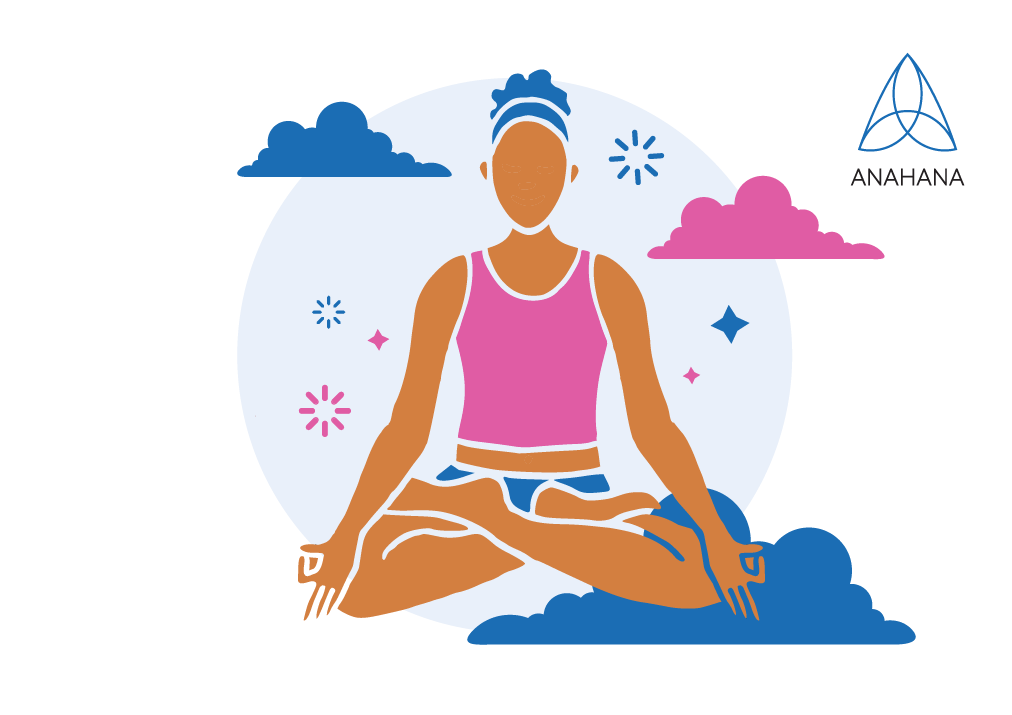 There’s no doubt that yoga is here for the long haul. But the question remains whether it will change fundamentally or remain essentially the same.
There’s no doubt that yoga is here for the long haul. But the question remains whether it will change fundamentally or remain essentially the same.
Trending projection tells that technology will likely have the most significant impact on yoga practice in the future. Already, yoga students seek yoga training online via YouTube or apps and websites that offer individual instruction via webcam or live feeds to group classes. At-home yoga practices allow beginners to feel more comfortable learning the ropes. And the ability to work one-on-one with highly skilled teachers means that even yogis in rural areas can receive advanced personal instruction.
Similarly, the popularity of biometric feedback technologies has enabled advanced practitioners and beginners alike to track their progress and improve based on their data. Devices like Apple Watches, Fitbits, and other wearables offer real-time data, such as the wearer’s heart rate, calories burned, and sleep quality. As these technologies improve, it’s only time before they become integral parts of certain yoga practices.
Frequently Asked Questions About Yoga
What is the point of yoga?
Yoga has many purposes. But generally speaking, the practice aims to harmonize the mind, body, and spirit through gentle, deliberate movements and physical poses. Yoga improves focus, breathing, posture, cardiovascular health, anxiety and stress, sleep, etc.
Does yoga change your body?
Yoga can change your body. The practice can help reduce inflammation, improve posture, increase strength and flexibility, reduce muscle tension, and even encourage fat loss when done correctly.
Does yoga change your brain?
Yes, yoga and meditation can change your brain with regular practice. With recent advances in understanding and technology, scientists now know about “neuroplasticity” and the brain’s ability to adapt and change it’s structure, even as we age. Brain cells, called neurons, form new connections among themselves, and the more you do something, the stronger these neural links become. Neurons that fire together, wire together.
Critical to understanding the brain and the mind’s role in maintaining our habits (both good and bad) are what the ancient yogis called samskaras. Samskaras are the habits of thoughts and actions, which get more profound like grooves on a muddy road. These grooves become neural circuits in the brain and body.
From the yogic perspective, every time you do or think something, you increase the likelihood that you will do it or think it again. In yoga, we learn to focus and control our minds and bodies, altering our brains over time.
Can you lose weight by doing yoga every day?
As a rule, yoga is not a go-to practice for encouraging weight loss. Still, it can be part of a healthy physical lifestyle. Similarly, when you engage in more dynamic, active forms of yoga, you may lose a certain amount of fat and develop leaner muscle. Also, gentle yoga that reduces stress and inflammation, and lowers the hormone cortisol, will help your body and mind regulate, let go of excess weight, and even help with impulsive habits or emotional eating.
Is yoga a religion?
Yoga developed in India as a part of Hinduism. It has also been associated with Buddhism and Jainism, among other religions. However, yoga itself is not a religion.
Why is yoga good for anxiety?
Central to yoga focuses on deep breathing, which can help slow down the heart rate and limit extraneous, restless thinking. This, combined with yoga's meditative and spiritual benefits, can substantially reduce stress and anxiety.
References
Get to Know the 8 Limbs of Yoga
What Is Yoga Nidra? – Cleveland Clinic.
How to do Vinyasa Flow | ClassPass.
Ashtanga Yoga IS Hard—A Beginner's Guide to How to Practice – OmStars.
Iyengar 201: The Strap Trick You Need to Try to Release Your Neck Tension
Intro to Chanting, Mantra, and Japa
What is Om Namah Shivaya? - Definition from Yogapedia
What is Shabda Brahman? - Definition from Yogapedia
Disclaimer
The contents of this article are provided for informational purposes only and are not intended to substitute for professional medical advice, diagnosis, or treatment. It is always recommended to consult with a qualified healthcare provider before making any health-related changes or if you have any questions or concerns about your health. Anahana is not liable for any errors, omissions, or consequences that may occur from using the information provided.

By: Clint Johnson
Clint is the driving force and founder of Anahana. Clint teaches Yoga, Pilates, mindful breathing, and meditation, catering to a global community of students and teachers.
